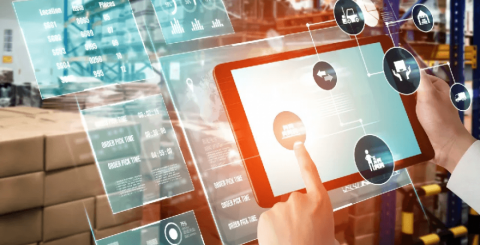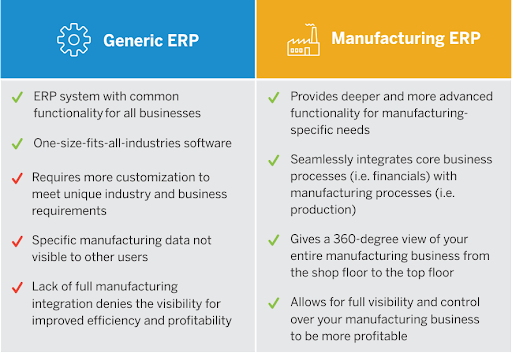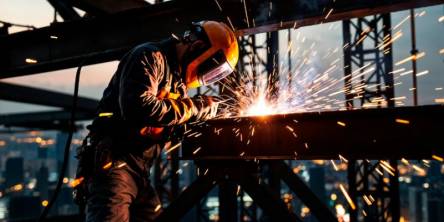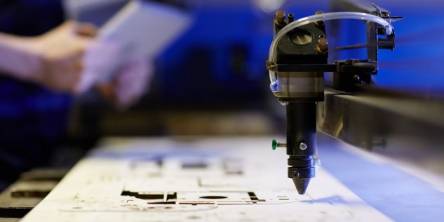The Future of Manufacturing: Leveraging ERP for Efficiency

Manufacturing is evolving rapidly. To improve efficiency and streamline operations, many businesses now use Enterprise Resource Planning (ERP) systems. ERP in manufacturing helps manage resources, optimize processes, and boost overall productivity. This blog will explore the future of manufacturing and how leveraging ERP can drive efficiency in the industry.
Understanding ERP and Its Impact on Manufacturing
At the core of modern manufacturing lies a complex network of interconnected processes. Each process depends on the others to produce the final product. Enterprise Resource Planning (ERP) systems act as the central nervous system. They coordinate and harmonize this complex ecosystem, transforming how manufacturers operate. The impact of ERP on manufacturing is profound. It marks a shift from traditional methods to a more streamlined, efficient, and data-driven approach.

Picture a conductor leading an orchestra. Each instrument represents a different department or function within a manufacturing company. ERP systems take on the conductor's role. They ensure every part of the business is in sync. This includes inventory, production, sales, and customer service. This seamless integration eliminates silos. It fosters communication across departments. It enables a holistic view of operations. The result? A harmonious symphony of efficiency. ERP systems drive down costs, improve productivity, and accelerate time to market.
ERP systems are data centers that gather information from various sources. They study that data to give insights and predict trends. This allows manufacturers to respond quickly to market needs, use resources better, and reduce waste. Imagine knowing exactly how much raw material is needed for production weeks ahead. Or being able to predict when machines need maintenance before they break down. This insight is very valuable in an industry where timing and efficiency affect profits.
ERP also helps with decision-making. Managers can access real-time data to make informed decisions that align with business goals. They can use ERP to optimize supply chains, streamline production schedules, or find cost-saving opportunities. ERP provides analytical tools for data-driven decision-making.
As manufacturing evolves with technology, ERP is becoming crucial. ERP lays a foundation for innovation, promotes collaboration, and drives efficiency. ERP impacts manufacturing, reshaping its future. Manufacturers with sophisticated ERP solutions can lead, adapt, and thrive in the new era of manufacturing efficiency.
The Evolution of Manufacturing in the ERP Era
Manufacturing has changed a lot with the help of Enterprise Resource Planning (ERP) systems. This new time is called the ERP Era. ERP systems have made manufacturing more efficient, flexible, and data-driven. They have replaced old ways of working with disconnected systems and separate departments.
In the ERP Era, ERP systems bring together different parts of the manufacturing process like getting materials, production, sales, and delivery. This integration has made operations smoother. It has also changed workplace culture to be more collaborative and open. Departments no longer work alone and hide information.
An important part of the ERP Era is making data available to everyone who needs it. ERP systems give access to data that was previously locked away. This helps employees make better decisions quickly. They can avoid delays and problems before they happen. This free flow of data leads to higher efficiency and a manufacturing process that can adapt fast.
ERP technology keeps getting better with features like artificial intelligence (AI), the Internet of Things (IoT), and machine learning. These are not just add-ons but are built into ERP systems. They provide predictions about production needs, automate tasks, and optimize resource use. ERP systems with these new technologies have enabled smart factories. Machines can communicate, fix themselves, and predict maintenance needs. This makes manufacturing even more efficient and reduces waste.
The cloud is changing how businesses work with ERP systems. Companies can now access their ERP from anywhere, anytime. This allows teams across the world to work together in real-time. It also helps businesses respond faster to market changes and supply chain issues.
The ERP Era is about more than just new technology. It's about interconnectedness, innovation, and efficiency. This journey is ongoing, driven by a desire for excellence. The goal is a more efficient, responsive, and sustainable manufacturing industry.
Key Features of ERP Systems That Boost Manufacturing
ERP systems are not just software in the manufacturing world. They help turn complex processes into streamlined ones. These systems are essential for boosting manufacturing. We will explore their key features that drive manufacturing success.
- Centralized data management is a core benefit of ERP systems. Imagine a library where shelves hold real-time data from all departments instead of books. You can instantly access this data. This helps make informed decisions without guesswork. Whether on the shop floor or in the boardroom, you have the information you need. This promotes transparency and efficiency.
- Automated Workflows act like a reliable spine for efficient operations. They automatically handle production tasks, reducing mistakes and saving time. From receiving orders to delivering products, automation ensures smooth flow through every manufacturing stage.
- Real-time Reporting keeps a close eye on the production floor. It provides continuous data that clearly shows what's happening. This helps address issues swiftly, like low stock or machine breakdowns. Decision-makers can adjust plans quickly and precisely.
- Demand Forecasting is like looking into the future. It analyzes past data and current market conditions to predict customer needs. This allows manufacturers to plan production schedules in advance. They can manage inventory levels efficiently, avoiding overproduction or shortages.
- Quality Control Monitoring safeguards product excellence. It automatically tracks quality from materials to final inspection. This comprehensive process builds customer trust and loyalty by ensuring every product meets standards.
By utilizing these powerful features, ERP systems boost manufacturing efficiency. They also pave the way for innovation, adaptability, and a lasting competitive edge in the fast-paced manufacturing world.
Overcoming Challenges in ERP Implementation
Starting the ERP implementation process can be like sailing into uncharted waters, with potential difficulties hiding like icebergs. These challenges, if not managed properly, can disrupt the smooth integration and optimal performance of an ERP system in a manufacturing environment. However, with careful planning and a proactive approach, these obstacles can become stepping stones towards achieving manufacturing excellence.
- One of the first challenges is transferring data from old systems to the new ERP platform. This data migration process can be complex, risking data loss or corruption. To prevent this, thoroughly clean and check the data before migration, ensuring only accurate, relevant, and up-to-date data is transferred. Using robust data validation tools and techniques can further protect against errors, maintaining the integrity of your data ecosystem.
- Another significant challenge is employee resistance, often due to fear of the unknown or discomfort with change. Cultivating an inclusive culture that actively involves employees in the ERP journey can dispel these concerns. Initiatives like comprehensive training programs, transparent communication about the ERP system's benefits, and creating ERP champions within teams can foster a sense of ownership and enthusiasm across the organization.
- Combining the new ERP system with existing software can be tricky. It requires carefully checking if the programs work well together. Working with ERP vendors who deeply understand integration methods ensures systems share data smoothly, boosting operational flow.
- Also important is ongoing training for employees. As ERP systems change over time, so should employee skills. Continuous learning ensures workers can fully utilize the ERP system's capabilities, driving sustained efficiency and innovation.
Implementing an ERP system doesn't just install new technology; it redefines how operations work. It sets the stage for unmatched manufacturing success driven by efficiency, agility, and insight.
The Future of ERP in Manufacturing: Trends and Predictions
The role of Enterprise Resource Planning (ERP) systems in manufacturing is revolutionizing. Its future combines cutting-edge tech and forward-thinking strategies. This allows businesses to operate with true agility, intelligence, and sustainability.
- One transformative trend integrates Artificial Intelligence (AI) and Machine Learning (ML) into ERP systems. Beyond automating routine tasks, this provides intelligent insights. It can predict market changes, optimize production schedules in real-time, and offer solutions for prescriptive maintenance. AI-driven ERP systems become insightful advisors, enabling preemptive strategies to minimize downtime and boost production efficiency.
- New technology is changing how companies manage resources. Blockchain offers new ways to track supply chains. In manufacturing, it could show every step from raw materials to finished products. This would help companies follow rules and build trust.
- Companies are also finding ways to reduce waste and pollution. Future software will measure and cut carbon emissions. It will help use fewer resources and follow environmental laws. With data, manufacturers can make smart, green choices.
- Internet-connected devices in factories provide a lot of new information. Software can use this data to predict machine problems, save energy, and improve processes.
As technology advances, software will drive innovation in manufacturing. It will lead to smarter, more sustainable, and connected operations.
How to Choose the Right ERP System for Your Manufacturing Needs
Picking the best software for managing your manufacturing business can feel overwhelming. But taking the time to understand your needs leads to better efficiency and growth. The key is matching your requirements to the tools different software provides.
- Before you select an ERP system, look closely at your manufacturing processes. What are your needs? Do you want an ERP system that manages inventory well in real-time? Or do you need advanced analytics and reporting features more? Every manufacturing business faces different challenges and has different goals. So you must choose an ERP solution that addresses your specific pain points and ambitions.
- Also consider scalability. As your business grows, your ERP system should adapt easily. Choose a solution that meets your current demands. But also look for one that can expand its functions smoothly as your business scales up. This forward thinking will save you from costly system replacements or overhauls later on.
- Customization options matter too. Some off-the-shelf ERP systems are ready to use quickly. But a customizable system can be tailored precisely to suit the nuances of your manufacturing operations. Customization can range from simple user interface tweaks to deeper functional adjustments. This ensures the system works for you, not vice versa.
- Finally, consider the vendor's reputation and support services. A vendor with a proven track record in manufacturing, and robust support, will provide expert guidance. This helps you navigate any challenges during and after implementation.
Consider the entire cost of owning an ERP system. This includes the initial cost as well as ongoing maintenance, support, and upgrade expenses. Understanding these costs clearly will help you make a financially wise decision, ensuring you get the best ERP for your manufacturing needs.
Picking the right ERP system is a crucial strategic decision. You must carefully think about and research several factors. By focusing on these key aspects, manufacturers can choose a system that meets current needs. It will also prepare them for future growth and efficiency.
Maximizing ROI from Your ERP Investment
To fully utilize your ERP investment and ensure a strong return, ongoing strategic efforts are needed. It's like tending a garden; regular care will yield great results. Start by creating a culture of continuous learning in your organization. Hold regular training sessions. This allows employees to use the ERP system's latest features, making them more productive and efficient.
Utilize updates and upgrades. Like a software gardener, remove outdated features and add new technology. This keeps your ERP system vibrant and growing. It also enhances performance and keeps you ahead in the competitive manufacturing landscape.
Performance reviews act as fertilizer. Periodically assess how different departments utilize your ERP system. This can reveal hidden inefficiencies or underused features. You can then make targeted improvements, ensuring every ERP aspect contributes to your bottom line.
Your ERP system produces useful data. Invest in advanced tools that can turn this data into insights. This can help with decision-making, forecasting, and improving your return on investment.
Working closely with your ERP vendor is important. Think of them as an expert gardener. Regular check-ins ensure your system aligns with your business goals. You'll also learn about new features that could benefit your operations.
By following these strategies, you're not just maximizing your ERP investment's return. You're also building a foundation for long-term growth and efficiency in manufacturing.
ERP and Sustainable Manufacturing: A New Way of Thinking
In modern manufacturing, sustainability is more than just a buzzword. It's a fundamental shift in how operations are approached. ERP systems are leading this change, serving as the key to eco-friendly practices. These practices balance productivity with caring for the planet. ERP systems weave together data that shows the path to greener manufacturing processes. By carefully tracking resource usage, ERP software helps manufacturers dramatically reduce waste and optimize energy use. This turns sustainability goals into measurable outcomes.
ERP platforms do more than just promote efficiency. They drive a cleaner, more sustainable manufacturing approach. They enable a transparent supply chain, from sourcing sustainable materials to delivering eco-conscious products. Each step meets strict environmental standards. This digital coordination fosters an environment where operational decisions consider environmental impact. It paves the way for a future where manufacturing thrives economically while promoting sustainability. In this new way of thinking, ERP systems are vital allies in the quest for a sustainable manufacturing legacy, not just tools for managing resources.
Experience seamless integration and optimization with leading ERP solutions. Find out why the best ERP solutions in India are essential for your success.
Conclusion
As we move through the manufacturing world, it's clear that ERP systems are crucial for efficiency and innovation. By joining data-driven choices, smooth operations, and a focus on sustainability, ERP has become a transformative force in manufacturing. From combining AI and IoT to embracing sustainable practices, ERP stands at the forefront of the industry's future. This blog explored ERP's role in enhancing efficiency, with case studies and key features that empower businesses. We looked at ERP implementation challenges and overcoming obstacles to maximize investment returns. Also, ERP evolution trends and predictions highlight its vital role in driving manufacturing toward agility, intelligence, and environmental stewardship.
Choosing the right ERP system is strategic - it requires understanding your business's unique needs and available solutions. By aligning with goals and embracing continuous learning and adaptation, manufacturers unlock unparalleled efficiency, innovation, and growth. In conclusion, manufacturing's future links to ERP systems' evolution and adoption. As businesses harness these tools, they pave the way for operational excellence and contribute to a more sustainable, interconnected world. The journey into new manufacturing efficiency is exciting, with ERP guiding the way. Now is the time to embark, readying ourselves for technology and human ingenuity converging to redefine manufacturing possibilities.
Similar Articles
When you see a steel ship in the harbor, the first impression is usually sheer scale.
Explore CNC turning—its components, process, benefits, applications, and future trends shaping modern precision manufacturing in various industries.
In the competitive industry of car manufacturing, attaining exceptional performance along with an innovative design needs the incorporation of modern manufacturing technologies
Facing delays, quality issues, or supply chain problems in hardware manufacturing? Learn the top 7 challenges—and practical fixes—to streamline production.
In the rapidly advancing landscape of high-tech manufacturing, electronics, and materials science, diamonds are no longer just gemstones they’re high-performance materials redefining what’s possible in technology.
A business in the manufacturing industry today has to ensure that it chooses the precision-engineered components suppliers keenly since the competition is very stiff
Selective Laser Sintering, or SLS, has established itself as one of the most reliable and widely used 3D printing technologies. This method is valued for its ability to produce complex, durable, and high-quality parts without the constraints of traditional manufacturing.
In the retail and display industry, the visual appeal of products is paramount. Customers are constantly drawn to displays that are not only eye-catching but also provide an immersive experience.
As previously established, CO2 laser technology operates by shining a high-power infrared beam on a mixture of gas that contains carbon dioxide, nitrogen, and helium. This technology is well known for the fact that it is able to engrave onto a variety of materials such as wood, glass, plastic, leather, and even some metals with high precision and without contact.









